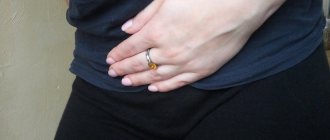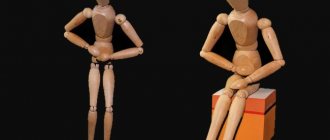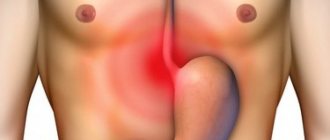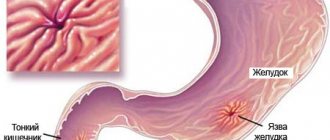Spread of pain from the rectus abdominis muscle
Myofascial trigger points located in the abdominal muscles may present with referred pain, which can be difficult to diagnose. False visceral pain, manifested from myofascial trigger points embedded in the abdominal muscles, can arise not only in the same segment of the abdominal wall; in addition, it can also radiate to the back. Painful sensations caused by trigger points are often accompanied by somatovisceral reactions, in the form of violent vomiting, nausea, loss of appetite, intestinal colic, loose stools, spasm of the sphincters and bladder, and menstrual irregularities. Such symptoms, accompanied by abdominal pain, may resemble acute diseases of the internal organs, for example, cholecystitis or appendicitis.
The rectus abdominis muscle is attached inferiorly along the crest of the pubic bone, with intertwining fibers at the level of the symphysis. At the top, the rectus abdominis muscle is attached to the cartilages of the ribs V, VI and VII. The fibers of this muscle are interrupted by three or four transverse tendinous septa, one of the three permanent septa located near the apex of the xiphoid process, another at the level of the umbilicus, and the third septum located midway between them. In some cases, there are also one or two bridges, partially formed, and they are located below the navel. The fibers of the upper rectus abdominis muscle can sometimes overlap the abdominal portion of the pectoralis major muscle, which can cause pain caused by myofascial trigger points in this area and radiating down the front of the chest.
The functions of the abdominal muscles are aimed mainly at increasing intra-abdominal pressure, flexion and rotation of the spine. The rectus abdominis muscle is the primary mover, providing flexion of the lower thoracic and lumbar spine. The rectus abdominis muscle is largely involved in the tension of the anterior abdominal wall, thereby causing an increase in intra-abdominal pressure.
A single group of muscles of the abdominal wall of the abdomen is involved in the implementation of rapid and complete exhalation during rapid breathing, helping to drive blood from the veins of the abdomen to the heart. When the abdominal wall relaxes at the moment of inhalation, blood flow in the abdominal veins increases, which stimulates the outflow of blood from the lower extremities.
When exhaling, in the absence of pathology of the valves of the veins of the lower extremities, the muscles of the abdominal wall contract and the blood tends upward to the heart.
The rectus abdominis muscle responds during walking to each step cycle during walking.
The rectus abdominis muscle is actively involved during a jump at the moment the feet lift off the support, but is not always active when landing.
When walking uphill, the abdominal muscles will be more active than when walking on the plain.
The rectus abdominis muscles, when flexing and extending the spine, are antagonists of the group of paravertebral muscles, especially the latissimus dorsi, and are synergists with the iliopsoas muscle, acting together during flexion of the lumbosacral region.
Associated symptoms with abdominal muscle injury
Only a doctor after a thorough diagnosis can tell why your stomach hurts and what caused the muscle tear. The first step is to evaluate for additional symptoms. They are divided into several types.
Pathogenetic signs include:
- colic, spasms in the smooth muscles. These symptoms always occur spontaneously. Sometimes they have a paroxysmal character. The intensity decreases after taking antispasmodics and warming procedures. Spasms radiate to the lumbar or dorsal region;
- referred abdominal pain. At the same time, it is aching or pulling in nature. In most cases, it is difficult to determine the location;
- paroxysmal pain. Occurs due to a sudden disruption of blood flow. It can grow very strong.
During diagnosis, the patient and doctor also need to determine the presence of other symptoms:
- If the painful feeling increases instantly and is acute and painful in nature, then this indicates perforation of an ulcer in the stomach or intestines, rupture of an aneurysm, myocardial infarction, biliary colic.
- When the pain syndrome appears unexpectedly, is intense and lasts more than 12 hours, then such symptoms indicate pancreatitis, intestinal obstruction.
- Painful sensations in the abdomen and muscles can increase gradually, but their duration can last up to several days. Then cholecystitis or diverticulitis is diagnosed.
- With appendicitis, cyst rupture and ectopic pregnancy, symptoms will occur in the form of tachycardia, blueness of the skin, a sharp drop in pressure, increased temperature, nausea and vomiting. In this case, it is necessary to urgently call an ambulance.
If there is a stretching of the abdominal muscles in men or women, the pain syndrome will have a pulling and aching character. The pain intensifies during movement, but goes away on its own after two to three days.
Innervation of the rectus abdominis muscle
The rectus abdominis muscle is innervated by 7-12 intercostal nerves, originating from the corresponding spinal nerves. The muscle fibers between the different tendon bridges are innervated by the nerves of different segments, especially in the upper half of this muscle.
Inside the rectus abdominis muscle or in its transverse sheath, compression of the anterior branch of the spinal nerve can occur, thereby provoking true rectus abdominis syndrome, which is characterized by pain in the lower abdomen or pelvic area, simulating a gynecological disease in women.
Causes of pain in the oblique abdominal muscles, why does the stomach hurt near the oblique abdominal muscle?
People often wonder about the sources and causes of pain in the oblique abdominal muscles, lower abdomen, and sides. Most often, the cause of discomfort is muscle overstrain from physical activity due to their lack of training. Therefore, the main cause of pain in the oblique muscles is considered to be excessive stress on them during training, especially if the exercises are aimed at working the abdominal muscles. Pain can also occur as a result of lifting a heavy object or moving heavy objects without specific preparation. Women's oblique abdominal muscles are additionally susceptible to painful symptoms in late pregnancy.
Diagnostics
Differential diagnosis of diseases caused by trigger points in the abdominal muscle wall should take into account diseases such as:
- joint diseases,
- fibromyalgia,
- appendicitis,
- stomach ulcer,
- cholelithiasis with colic,
- colitis,
- diseases of the urinary system,
- menstrual irregularities,
- chronic pain in the pelvic cavity
- and other diseases.
When examining a patient, it is very important to pay serious attention to the patient’s posture when walking, standing and sitting.
Anamnestic data can help identify the cause of complaints of pain. The doctor draws up an accurate pain distribution diagram based on the patient’s words.
Myofascial trigger points of the rectus abdominis muscle depress its supporting function. If they are present in the rectus abdominis muscle, the patient's stomach sag when standing. A tight cord is felt throughout the abdomen, which is associated with an active trigger point, shortening only one segment of the muscle between the transverse tendon bridges in which it is located.
An active myofascial trigger point inhibits the contraction of adjacent segments of the rectus abdominis muscle. Contraction would help relieve tension in the affected muscle fibers, lengthening, rather than shortening the entire muscle as a whole. When taking deep breaths, the patient exhibits paradoxical breathing. While during quiet breathing exhalation is carried out due to the elasticity of the lungs and less assistance from the muscles is required, patients will subconsciously restrain the normal contraction of the diaphragm during inhalation, due to fear of pain when stretching the rectus abdominis muscle. This is a reflex inhibition of the muscles - the diaphragm and rectus abdominis.
And at the moment when the patient takes a deep breath with the participation of the diaphragm and thereby causes a protrusion of the abdomen, the pain reflected from the trigger points sharply worsens.
If there are trigger points in the rectus abdominis muscle, referred pain may be distributed along both sides of the spine, across the lower back. With deep breathing, the pain always intensifies, in particular when the back is straightened in the presence of pronounced lumbar lordosis, which subsequently causes stretching of the rectus abdominis muscle. Back pain caused by trigger points of the paravertebral muscles does not always affect the act of breathing. A hernial formation in the abdominal cavity is detected with the patient standing.
If the muscles in the abdomen are very sore after training, what are the reasons and what to do?
To relieve severe pain after an intense workout, abdominal cramps and colic, another workout, but with less load, will help. To prevent injury, it is important during exercise not to try to master exercises that are too difficult for you at this stage. First of all, you should objectively assess your real current capabilities. The load must be increased gradually, guided by the trainer’s recommendations. Before and after training, you need to pay enough attention to warming up, stretching and cooling down. This will help prevent sore throat, relieve, eliminate severe muscle pain or make its unpleasant manifestations minimal. A hot shower or bath is also considered an effective method for overcoming sore throat. This will help relax the muscles after the work done. For greater effect and more pleasure, you can add a few drops of essential oil to your bath.
Symptoms caused by trigger points located in the abdominal muscles
Difficult-to-explain abdominal pain can often cause diagnostic confusion.
Referred pain caused by myofascial trigger points located in the abdominal muscles and somatovisceral effects can mimic diseases of the internal organs and systems.
In another case, on the contrary, with diseases of internal organs and systems, there is a profound impact on the sensitive somatic system of reflex activity. At the same time, active myofascial trigger points are aggravated, which causes the persistence of pain and other symptoms for a long time, even after the patient has recovered from the initial disease.
Active myofascial trigger points, localized in the abdominal muscles, for example, in the rectus muscle, can cause conditions such as: difficult muscle contraction, with the inability to “pull in” the stomach, relaxation, bloating. It is important to differentiate this condition from ascites.
Referred pain in the right upper quadrant can be caused by trigger points located along the outer edge of the rectus abdominis muscle. They can mimic the pain that accompanies gallbladder disease.
Referred pain simulating appendicitis may be projected from trigger points located in the lateral border of the rectus abdominis muscle and in the right lower quadrant.
Causes of pain in the muscle structures of the abdomen
It is not always possible to accurately determine the location of the pain. It all depends on their reason for their appearance. In medicine, there are three main factors that lead to pain in the abdominal area.
These include:
- diseases of the hollow organs, which are located in the abdominal part. This same group also includes a clinical condition called “acute abdomen”;
- reflected, radiating or extraparietal sensations. They are caused by pathologies that occur outside the abdominal cavity. This group includes diseases of the spinal column, cardiac region, endocrine system and lungs;
- pathological processes of a systemic nature.
Muscle pain in the lower abdomen often occurs when exposed to psychogenic factors. Many people are familiar with the situation when they experienced physical overexertion, sports overload on muscles, depression.
Most often, the muscles in the lower abdomen hurt due to spastic tension and hypertonicity. This condition is often considered a protective feature. Pain always occurs in the place where the injury was caused or inflammation occurred.
The degree of manifestation of an unpleasant feeling depends on the speed of spread of the inflammatory process, as well as on the functionality of the nervous system.
When abdominal pain is characterized by an acute course, the cause may be hidden in the following:
- acute appendicitis;
- perforation of an ulcer in the intestinal canal or stomach;
- acute intestinal obstruction;
- vascular abnormalities in the form of impaired arterial or venous outflow of blood, ischemia, infarction of the intestinal tract;
- acute inflammation in the gallbladder or pancreas;
- rupture of the tube due to the development of an ectopic pregnancy;
- aortic aneurysm in the abdominal cavity;
- acute inflammation in the pelvis in the female half of the population.
If acute type anomalies are excluded, then why do the abdominal muscles hurt? Then the reasons may be hidden in the following:
- pinching of a hernia or prolapse of internal organs through a hole formed in the abdominal wall;
- stretching of the abdominal muscles. Very often, pain occurs due to small microtraumas in the internal structure of muscle fibers. The reasons are physical overexertion, strain, sports training, carrying heavy loads;
- injury to the abdominal area with a blunt or sharp object. This process leads to the formation of intra-abdominal bleeding. In the absence of timely assistance, peritonitis develops. Blunt trauma often results in the formation of an intra-abdominal hematoma and the appearance of abdominal pain;
- rupture of abdominal ligaments and muscles. This phenomenon is characterized by a violation of the integrity of the muscle tissue structure. The rupture can be either partial or complete. Spontaneous breakdown of muscle fibers occurs during intense physical activity.
Stomach pain can also occur for other reasons in men and women, for other reasons:
- osteochondrosis of the lumbar region;
- spondylosis;
- tuberculosis of the skeletal system;
- spinal column injury.
Much more dangerous is the condition when pain occurs when the walls of a hollow organ are perforated. This can cause hemorrhage and death of some tissues.
Activation and long-term existence of myofascial trigger points
The reason for the long-term existence of myofascial trigger points can be structural and systemic factors, as well as posture and physical activity that are not corrected in a timely manner.
Muscles that are acutely or chronically overused can cause trigger points. Severe injuries, diseases of internal organs, emotional stress, as well as mechanical and toxic stress can cause the development of myofascial trigger points.
The location of active myofascial trigger points of the rectus abdominis muscle is usually the angle between the xiphoid process and the costal arch or between the umbilicus and the xiphoid process. In addition, trigger points can be located in the middle or lower part of the rectus abdominis muscle, along its lateral edge and in the area where the muscle attaches to the pubic bone.
Releasing Myafascial Trigger Points
Release from myafascial trigger points is facilitated by post-isometric relaxation, methods of contraction and relaxation, methods of cooling and stretching the abdominal muscles. The release method using fingertip pressure on a painful trigger point is only applicable to the superficial external rectus abdominis muscle. To treat myofascial trigger points at the insertions of the abdominal muscles, it becomes necessary to inactivate the central trigger point that causes them.
Corrective Actions
The persistence of the activity of the myofascial trigger point for a long time after the onset of an acute disease of the internal organ is facilitated by the fact that the initial cause, that is, the underlying disease - a tumor, stomach ulcer, intestinal paresis - has not been eliminated. Therefore, treatment aimed at getting rid of myofascial trigger points will give a temporary, partial effect. For a complete cure, it is necessary to eliminate the causative factor - a disease of the internal organ.
When a muscle remains in a stressful state for a long time, such as: emotional stress, viral disease, mechanical distortion, poor posture, stoop, it is also important to eliminate the cause that does not contribute to healing.
The patient should place a small pillow on the chair to support the lower back and sit leaning back in the chair. In this position, the lumbar lordosis increases, the chest rises slightly, and the longitudinal muscle fibers of the abdominal wall stretch.
It is necessary to avoid wearing a tight belt in order to improve blood circulation in the muscles.
Physical exercise
It is important to regularly perform special exercises for a long time to maintain normal muscle tone and form the correct pattern of movements.
The patient needs to perform therapeutic exercises, consisting of exercises to strengthen the abdominal muscles, aimed at developing diaphragmatic breathing and eliminating pelvic distortion.
All rights reserved by copyright law. No part of the contents of the site may be used, reproduced, transmitted by any electronic, copying or other means without the prior written permission of the copyright owner.
During pregnancy, pulling in the lower abdomen
8 Mar 2020 | Comments are disabled
The resulting pregnancy is a mass of changes in the female body, in clear and well-functioning work. All pregnant women are constantly listening to these new sensations, and sometimes they cause anxiety. Such “alarming” signals also include unpleasant pain in the lower abdomen, and they occur at any stage of pregnancy.
So what is the reason why the stomach actually pulls during pregnancy? Such pain in the lower abdomen should not be a special reason for panic if it is irregular, without accompanying discharge, if it does not cause severe discomfort - most likely this is a natural reaction of the body to the enlargement of the abdomen, its stretching under the influence of the growth of the fetus.
Often it is because of this that the stomach pulls, and this is absolutely natural. Stretching the muscle mass and skin of the abdomen leads to stimulation of the nerve fibers that are located in them. These fibers are thus simply “perturbed” by excess tension.
It’s another matter when the lower abdomen pulls during pregnancy, and all this is accompanied by other unpleasant sensations. Let's look at the reasons why the stomach feels tight during different periods of pregnancy, and what can cause acute pain in the lower abdomen.
Why does the stomach feel tight during early pregnancy?
If the expectant mother is still very young, her body is not fully formed, and during pregnancy her lower abdomen feels tight for the reason that the pelvic bones experience a strong load for which the body is not yet ready. The uterus is also not yet fully formed, there is a high risk of miscarriage or placental abruption.
If you experience abdominal pain and spotting, you should immediately consult a doctor. Even if there is no such discharge, but there is severe intestinal upset, diarrhea, nausea, general weakness, consultation with a specialist is simply necessary. Sometimes there are all the symptoms that indicate a threat of miscarriage - nagging pain in the lower abdomen, weakness, spotting - but this is simply the reaction of the young body to the period of menstruation.
The hormonal levels increase, the body is tuned in to the passage of menstruation, and then pregnancy - it (the body) is still young and young, it is not able to understand the difference, therefore it acts as it should for this age. He behaves as if he were menstruating, but pregnancy is not yet recognized by him as a fact.
Why does the stomach feel tight in early pregnancy?
In the case when pain in the lower abdomen accompanies pregnancy in the early stages, contacting a gynecologist is simply necessary. And in the shortest possible time, it’s better not to joke about it. The cause of such pain can be either an ectopic pregnancy or an active threat of miscarriage. What indicates a state of threat of miscarriage in its early stages:
• there was discharge containing blood;
• during pregnancy, the lower abdomen periodically and strongly pulls, discomfort has appeared in the lumbar region, and such sensations intensify with each physical activity;
• severe weakness appeared, dizziness and periodic nausea began. If these symptoms appear, you should immediately consult a doctor and act strictly on his recommendations.
What indicates a threat of ectopic pregnancy if the stomach is strongly pulled during pregnancy:
• the pain goes from aching and dull to strong and sharp, sometimes even stabbing;
• there is a complete lack of desire to eat, vomiting often occurs, general weakness almost knocks you down;
• pallor appears and blood pressure drops sharply, fainting may occur;
• pronounced bloody discharge, it can intensify when the tube ruptures and turn into bleeding.
If you have such symptoms, you need to urgently call an emergency ambulance team, otherwise it could end very badly.
If your stomach feels tight towards the end of pregnancy
When your stomach feels tight later in pregnancy, you should definitely consult a doctor - whether the pain is short-term or long-term. During advanced pregnancy, such pain can even be caused by intestinal bloating, but its cause must be accurately determined. Any disorder in the mother’s body immediately affects the baby, who is firmly connected to her.
It happens that during pregnancy the lower abdomen feels tight even when there is a sharp jump in the growth of the fetus. This happens when a child is supposed to be born large, but the mother’s body does not have time to rebuild. Sharp pains that occur during normal coughing or sneezing may also appear; they often resemble contractions.
The doctor will immediately prescribe an ultrasound, which will show this growth spurt and recommend the mother a diet that will ensure that the deficiency of vitamins is replenished, which often happens with accelerated growth of the fetus. For such mothers, it is best to do yoga or Pilates, which will strengthen the muscles, and then carry a large baby with less damage to health.
When the stomach is very tight during pregnancy, and the term is already 32 or 34 weeks, and the stomach begins to harden, this is a signal that premature birth is possible. Here you need to see a doctor urgently! Especially if, with such pain, a discharge appears, which doctors call spotting.
In such cases, the mother will most likely be admitted to a hospital to continue the pregnancy. At this stage, the baby’s lungs are still forming, they have not yet expanded, so childbirth can cause the death of the fetus.
If the pain is sharp and pronounced, very similar to contractions, then you also need an ambulance. Such pain most often indicates placental abruption, which can lead to hypoxia in the baby and he will not get enough oxygen.
Such symptoms most often appear after severe physical overexertion, an “unscheduled” surge in pressure, perhaps from an injury suffered by the mother. When bleeding begins with such pain, the only way to save the baby is an urgent and competent caesarean section. The sooner a doctor is called, the higher the likelihood that both the baby and mother will remain alive and healthy.
Factors influencing pain in the lower abdomen
The factors why the stomach feels tight during pregnancy are very different, but it is always better to consult a doctor to find out these very reasons. The sooner the reason why your stomach is pulled is determined, the more time you will have to solve the problem.
There are, for example, women with a narrow pelvis, and such pain indicates that this very pelvis is trying to expand and take on the shape that will allow the mother to give birth to a baby. But only a doctor will be able to correctly assess the degree of pelvic expansion in order to schedule a caesarean section for a woman in time if patency is low at the time of birth.
Previously, even before the advent of widespread ultrasound, (experienced) doctors determined this degree of expansion by eye based on signs known to them. If the doctor did not have sufficient experience, the baby could be born with a fractured collarbone or dislocated hip. This is not fatal, of course, but often such a dislocation of a baby’s hip during childbirth led to, albeit a slight, lameness in adulthood.
Mothers who ignore going to the doctor when they have abdominal pain during pregnancy because the pain is insignificant and not severe, simply apparently forget that now every “oh, it hurts a little” can result in a big problem for the baby.
For example, the baby pushes hard and after his pushes the mother feels a strong tug in her stomach; the mother thinks that this is simply from the “kicks of the football player” who is sitting inside. The woman does not consider it necessary to see a doctor, she only complains that this “football player” is often spinning inside, and she can accompany these complaints with tenderness and even joy.
But during childbirth, at the last moment, it turns out that the child has a strong entanglement in the umbilical cord, the baby begins to choke, and it is too late to do a caesarean section. The child does not come out, forceps are applied to his head, and an opportunity is sought to remove the baby with the least damage.
It’s good if there is a team of obstetricians with extensive experience and skill in such matters. The least that can happen in this situation is hematomas on the baby’s skull from compression with forceps, short-term hypoxia of the baby, severe nervous stress for all the staff and the mother.
If the woman had consulted a doctor on time, the entanglement of the umbilical cord would have been recorded by ultrasound results, a planned caesarean section would have been prescribed, and no rush would have occurred during spontaneous childbirth.
Above, I described to you the consequences of such “extreme emergency” childbirth with the best outcome. At worst, terrible things can happen, from severe compression and deformation of the baby’s skull and facial bones, to death due to the incompetence of the maternity room staff.
Any pain in the lower abdomen during pregnancy occurs for some reason, and only a gynecologist can determine these reasons. There is no need to treat even mild pain as something insignificant - you are risking not only your health (and sometimes your life), you are risking the little person who is growing inside you and so needs your attention and care, starting with intrauterine period!
loading…
Stomach pain during pregnancy
Every expectant mother, knowing about her situation, treats her body with caution so as not to accidentally harm her baby. Understanding the full responsibility of her position, at the first sign of possible danger she immediately begins to sound the alarm!
Abdominal pain during pregnancy is regarded by the expectant mother as a possible threat to the fetus. However, abdominal pain during pregnancy is not always a sign of a miscarriage or some kind of trouble.
If you experience stomach pain during pregnancy, there is no need to worry. First you need to determine what this pain is associated with.
Why does my stomach hurt a lot during pregnancy?
Most often, abdominal pain can be caused by poor diet. This can lead to spasms of the digestive system and end in aching pain in the lower abdomen.
It is also not uncommon for nagging pain in the lower abdomen during pregnancy to be caused by a sprain of the ligaments and muscles that support the uterus. As the uterus enlarges, pressure on the ligaments increases, so if you move suddenly, sneeze or cough, you can feel the ligaments being stretched. So if you have pain in your lower abdomen during pregnancy, it's most likely a sprain, which is not particularly dangerous, just be careful in the future.
If you have pain in your upper abdomen during pregnancy, this could also be due to an enlarged uterus. An enlarged uterus can press against chest organs such as the liver and gallbladder. As a result, the process of bile secretion may be disrupted, which may be accompanied by pain in the upper abdomen during pregnancy.
Does your stomach hurt during pregnancy?
An absolutely healthy pregnant woman may also experience abdominal pain. It often happens that women have abdominal pain on the right side during pregnancy. This is often due to the location of the fetus in the uterus. The pain may increase with fetal movements, and be accompanied by a lack of appetite and a feeling of heaviness. Pressure in this area of the abdomen can also lead to heartburn, a bitter taste in the mouth, and bloating.
Next, we will look at the most common causes of abdominal pain and methods for eliminating them.
Abdominal pain during ectopic pregnancy
An ectopic pregnancy is the process of development of a fertilized egg not in the uterine cavity, but in the fallopian tube. An ectopic pregnancy can be easily determined using an ultrasound, as well as by its first signs: dizziness and sharp abdominal pain (provided that the pregnancy test is positive). The enlarging egg ruptures the tissue of the fallopian tube, causing pain and bleeding.
This usually happens in the fifth to seventh week of pregnancy. In this case, only surgical intervention can help.
Abdominal pain associated with miscarriage
If there is a threat of miscarriage, a prolonged aching pain in the abdomen is felt, radiating to the lower back. Typically, such pain is accompanied by bloody discharge from the genitals.
Women with a threat of miscarriage are immediately taken to the hospital, where hormonal levels, the condition of the fetus, and the presence of infections that can cause pregnancy disruption are carried out. After determining the cause of the pregnancy disorder, special treatment is prescribed.
Abdominal pain due to premature placental abruption during pregnancy
Sometimes abdominal pain during pregnancy can occur in case of premature placental abruption. The placenta separates from the wall of the uterus before the baby is born.
The cause of premature placental abruption can be abdominal trauma, physical stress, hypertension, toxicosis in the second half of pregnancy, etc.
With premature placental abruption, blood vessels rupture, accompanied by severe pain in the abdominal area and bleeding into the uterine cavity. If such symptoms appear, it is necessary to call an ambulance, because the way out of this situation is a quick delivery and stopping the bleeding in the expectant mother.
Abdominal pain during pregnancy due to digestive organs
The increasing size of the uterus can put pressure on the digestive organs that are in close proximity to it, which can lead to unpleasant sensations.
Also, with changes in hormonal levels, a woman’s food preferences may change, as a result of which a pregnant woman may consume foods that can cause various metabolic disorders. For example, frequent consumption of spicy and sour foods can lead to irritation of the stomach walls; consumption of sweet foods can cause fermentation in the intestines and dysbiosis. Dysbacteriosis can also cause bloating during pregnancy. Switching to healthy foods can help solve this problem, but do not neglect to consult a doctor who will prescribe special medications.
Abdominal pain during pregnancy due to muscle and ligament sprains
During pregnancy, the growing uterus can cause the ligaments that support it to stretch. The process of spraining the ligaments is accompanied by short-term sharp pain in the lower abdomen, which can intensify with heavy lifting, coughing, and sudden movements. Pain can also occur from overstraining the abdominal muscles.
During pregnancy, abdominal pain of this nature does not require special treatment; it is enough to rest for a while and allow the body to recover. Such pain poses more of a psychological danger than a physical one. The expectant mother may not know about the origin of the pain and become very worried about it, which can lead to stress or mental illness. And a pregnant woman does not need unnecessary worries.
Abdominal pain during pregnancy associated with surgical diseases
A pregnant woman, like any person, may have appendicitis, acute cholecystitis, etc. In this case, only surgery can help.
If you experience any pain in the abdomen, you should go to the gynecologist,
so that he can determine the cause of the pain, reassure the woman and, if necessary, refer her to the hospital for treatment in order to prevent possible complications. Related articles:
| Back pain during pregnancy The vast majority of pregnant women experience back pain during pregnancy. Moreover, pain can appear even when the woman herself does not yet know that she will soon become a mother. What then is the cause of these pains? You will find the answer to this question in our material. | Menstruation during pregnancy One of the main signs of pregnancy is considered to be the absence of menstruation. But what happens when pregnancy is confirmed, but your period still comes on time? Is this a threat to the unborn baby or is there no reason to worry? You will find answers to these questions in our material. |
| Colds during pregnancy - 2nd trimester Often, expectant mothers feel quite well in the second trimester of pregnancy - after all, the first worries and anxieties, and with them toxicosis, are already behind them. However, even the most common cold during this period can cause dangerous consequences for a woman and her baby. | Colds during pregnancy - 3rd trimester In this material, we decided to dwell in detail on how a mother’s cold affects a baby already fully formed in her womb. Of course, you should not take everything you read here to heart, but in this situation, it is better to be warned than to reap the fruits of your negligence. |
Don't know what to wear? Become fashionable immediately!Your name *Email address *Other articles:Kidney stones during pregnancy The kidneys have to carry an increased load during pregnancy. Therefore, it is often during this period that a woman can detect the presence of pathologies in this organ. What kidney problems can be detected, how they manifest themselves, what to do in such cases - read our article. Heartburn during pregnancy - what to do? Pregnancy is such a happy, but at the same time difficult time for every woman, because during this period chronic diseases tend to worsen and new troubles appear. Such, for example, as constant, painful heartburn. We will now tell you how to deal with it. Urinalysis during pregnancy - explanation The urinary system is the first to respond to any changes in the body, which is why doctors so often force pregnant women to take tests. Read our article about what a urine test can tell you during pregnancy. And stock up on jars!
Lower abdomen feels tight during pregnancy
Published September 3, 2012 | Author:my pregnancy
Nagging pain in the lower abdomen can occur both at the beginning and at the end of pregnancy. These are not dangerous pains; they are caused by physiological changes in a woman’s body. But it is best to contact an obstetrician-gynecologist at the antenatal clinic; perhaps something more serious is hidden behind such pain.
The lower abdomen feels tight during pregnancy - pain that is not dangerous
Nagging pain in the lower abdomen can occur even in the first weeks of pregnancy. In most cases, this is due to hormonal changes in the body, which affect all organs and tissues. There is a change in the pregnant woman’s attitude towards her body; she constantly listens to what is happening inside.
If previously minor abdominal pain could be almost unnoticeable, then during pregnancy they are considered of great importance. There is nothing wrong with this, you need to monitor your feelings, you need to consult your doctor about everything, just don’t panic.
Nagging pain in the lower abdomen can occur due to the fact that, under the influence of hormones, the ligaments and muscles that support the abdomen begin to gradually change. The body begins to prepare for increased stress. At the very beginning of pregnancy, the abdominal muscles gradually soften; in the second half of pregnancy, as the abdomen grows, stretching occurs - this causes nagging pain.
The growing uterus can also have some impact on surrounding organs and tissues, causing discomfort that often occurs in women who suffer from painful periods.
Another cause of nagging pain in the lower abdomen is congestion in the intestines, which also appears against the background of hormonal changes. The main hormone of pregnancy, progesterone, suppresses the motor activity of the muscles of the uterus - thus the body protects the fetus from miscarriage. A side effect of this action is the suppression of the motility of the smooth muscles of the intestines, since the autonomic fibers that innervate the muscles of the uterus and intestines come from common nerve trunks. As a result, areas of feces accumulation can form in the intestines, which then cause nagging pain in the abdomen in the direction where such a “congestion” forms.
The lower abdomen feels tight during pregnancy - how to cope?
First of all, you need to contact an obstetrician-gynecologist at the antenatal clinic; if there are no serious reasons for concern, then you need to adjust your diet and lifestyle.
It is difficult to prepare for the fact that constipation will be constant throughout pregnancy. Only proper nutrition will help you cope with this situation. Fermented milk products (fresh kefir, but already on the third day it can fix), vegetables (fresh in salads and stewed), fruits should come to the rescue. You can add vegetable oil to vegetable salads, which has a laxative effect.
Do not use laxative medications, if the situation is critical, then only a doctor should prescribe such medicine.
Pregnant women can only use medications that do not increase intestinal motility, as otherwise this may cause miscarriage.
The pain that is associated with muscle stretching and the pressure of the uterus on surrounding tissues can be tolerated, they are not severe. Alternate rest and light physical activity, as a result the pain decreases. A bandage for pregnant women is often used (only worn while lying down); the bandage reduces stretching of the abdominal muscles.
The lower abdomen feels tight during pregnancy - when to sound the alarm
Pain in the lower abdomen can occur when the muscles of the uterus are tense. This is the so-called uterine hypertonicity - a dangerous condition that can lead to miscarriage. However, uterine hypertonicity is treatable and therefore ceases to be dangerous. You just need to see a doctor in time. At the very beginning of pregnancy, uterine hypertonicity most often occurs due to the synthesis of the hormone progesterone in the pregnant woman’s body. The administration of its synthetic analogues (utrozhestan during pregnancy, duphaston during pregnancy) restores the normal state of the uterus. You should not ignore uterine hypertonicity; this condition must be treated without fail, since muscle spasm compresses the fertilized egg, and as a result, the fetus suffers.
An even more dangerous condition is when bloody discharge may be added to the nagging pain in the lower abdomen. In this case, there is a threat of termination of pregnancy; the body is trying to get rid of the fetus. In this case, you should immediately call an ambulance. The pregnant woman must be taken to the hospital on time; at the very beginning of spontaneous abortion, it must be stopped and prevented.
You need to treat your feelings during pregnancy without unnecessary nervousness or tension, then you will be able to recognize the danger in time and seek medical help.
We recommend reading articles on pregnancy
- Pregnancy after a frozen pregnancy (0) A frozen pregnancy is a grief for the pregnant woman, as well as for her loved ones. This is a big psychological trauma. But don't despair
- Torch infections (0)Is it necessary to do tests for Torch infections during pregnancy? Does this need to be done in a paid laboratory or can they be submitted to
- Macrosomia (0)Macrosomia is a large body translated from Latin. If you find that your abdominal circumference is extremely large in
- How to deal with toxicosis (2) Pregnancy is often associated with toxicosis. It manifests itself differently for everyone. Some pregnant women do not know what toxicosis is because
- 3rd trimester screening (0)3rd trimester screening is carried out between the 32nd week of pregnancy and the 34th week of pregnancy, important and close attention is paid to ultrasound
- Constipation during pregnancy (1) Most pregnant women have problems with bowel movements. In half, constipation during pregnancy persists throughout
- (0)What is hepatosis in pregnancy? The full name of this disease is cholestatic hepatosis of pregnancy. Hepatosis of pregnancy affects the liver.
In what cases can a healthy person have a tugging sensation in the lower abdomen?
Before menstruation (PMS)
Nagging pain in the abdomen, especially in its lower part, in girls and women of reproductive age every month reminds of the imminent onset of menstruation.
In addition to aching pain in the abdomen and lower back, premenstrual syndrome is often accompanied by headache and psycho-emotional stress:
- irritability,
- tearfulness,
- depressive state.
All this helps women easily determine the beginning of a natural process in their body. Why are so many representatives of the fair sex forced to experience monthly pain in the lower abdomen, sometimes quite intense and prolonged?
Menstruation is evidence that fertilization of the egg has not occurred. The uterus does not need a layer of endometrium covering it, the function of which is to create optimal conditions for the acceptance of the embryo and the course of pregnancy.
The removal of the endometrial mucosa occurs due to the contraction of the smooth muscles of the uterus, the spasms of which cause pain in the abdominal area. Prostaglandin hormones are responsible for uterine contractions during menstrual periods; the level of their concentration in the blood determines the motor activity of the uterus and the intensity of sensations.
During ovulation
During the rest of the menstrual cycle - during the period when there are no periods - processes occur that prepare the woman’s body to become a mother. Therefore, a slight aching pain on the left or right in the groin approximately one and a half to two weeks after menstruation is usually also not a cause for concern.
Minor discomfort for a couple of days in the middle of the cycle indicates ovulation: the maturation and release of the follicle from the ovary, which may be accompanied by minor damage to the blood vessels and slight bleeding from the vagina.
Echoes of this process often cause minor pain: depending on which ovary the egg came from, the pain is localized on the left or right.
In addition, a woman may experience:
- slight increase in body temperature,
- heaviness in the mammary glands,
- nausea,
- copious white discharge of clear mucus (or slightly pink).
These signs are harmless and indicate healthy ovulation. In addition, the listed factors help calculate the optimal timing for successful conception, since a week after ovulation there is practically no chance of a favorable outcome.
When pregnancy occurs
If a woman has a delay (there is no period at the beginning of a new cycle), and the body gives signals similar to symptoms of premenstrual tension, we are most likely talking about a joyful event: the onset of pregnancy. A delay in menstruation, morning sickness and a nagging pain just above the groin leave no doubt that a small new life has arisen.
At the beginning of pregnancy, the stomach often feels tight, like during menstruation. The fact is that after ovulation, the fertilized egg reaches the uterus only at the end of the cycle - around the time of the onset of the next period - so the process of attaching it to the walls of the uterus is often confused by women with PMS.
The main reproductive organ in girls - the uterus - accepting the invasion of a “foreign body”, is forced to adapt its muscle tissue for further peaceful coexistence. Therefore, egg implantation is accompanied by damage to epithelial cells, which explains the pain syndrome and the presence of minor bleeding in the early stages of conception.
In later stages, pain localized below the navel occurs due to:
- increasing the size of the abdomen,
- increasing load on the ligamentous apparatus of the uterus,
- pressure of the uterus on neighboring organs,
- softening of the pelvic bones and ligaments.
For flatulence and stool disorders
Bloating and pain in the lower peritoneum are a common complaint in men and women with flatulence and stool disorders.
By processing food that promotes increased gas formation (legumes, sauerkraut, baked goods, fast food, carbonated drinks, etc.), bacteria in the intestine release gases, which, when accumulated, begin to put pressure on its walls and negatively affect motility.
In pregnant women, additional pressure on the intestines is exerted by the enlarged uterus, aggravating the problem with belching, hiccups and bad breath.
As a result, there may be a delay in bowel movement - constipation, or, conversely, loose stools - diarrhea. The same situation can occur with a lack of intestinal microflora due to taking certain medications and gastrointestinal diseases. In addition, the cause of heaviness in the abdomen and indigestion may be poisoning.
During constipation, pain is caused by a large amount of feces, which creates pressure on the intestinal walls. He, in turn, begins to put pressure on organs located nearby. With diarrhea, pain and heaviness provokes stretching of the intestinal walls and spasms of smooth muscles.










